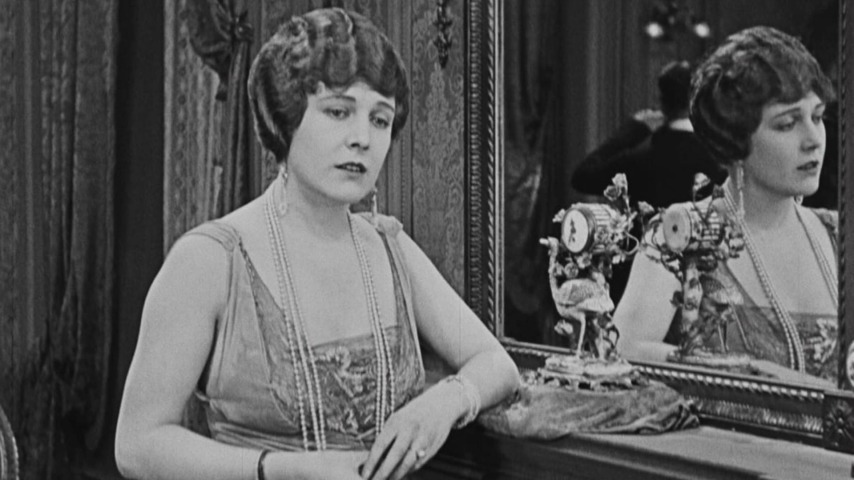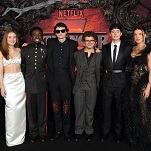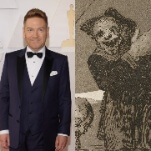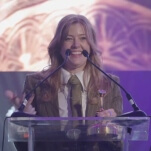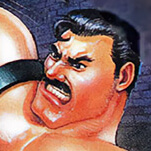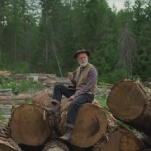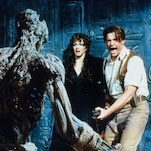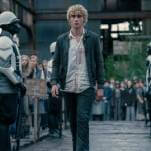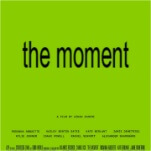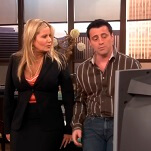Purviance plays Marie St. Clair, a poor French woman constantly at the mercy of weak men. She’s initially in love with Jean (Carl Miller), which angers her stepfather. After being kicked out of her home, she’s left at the train station by Jean, whose father has seemingly keeled over at the news that his son is running off with a girl. So, at the mercy of romance movie plotting—it’s 102 years later and the genre still hasn’t escaped the tropes of “overheard the exact wrong thing” or “not enough time to explain”—Marie takes the train alone to Paris. She leaves village life behind and with it, Jean.
A year later, she’s the kept woman of playboy Pierre (Adolphe Menjou, the HUAC-lover who became a star here and would end his career bloviating wonderfully in Stanley Kubrick’s Paths Of Glory), and accidentally reconnects with Jean when she waltzes into the wrong apartment in search of a party. A Woman Of Paris is about her decision between the two men, and about a woman’s position in the heart of the 1920s, in rowdy Paris, in the lap of flappers and hedonistic all-nighters. It’s also about the hedonism itself, which afforded glimpses of opportunity to enterprising (and perhaps unscrupulous) young people while never quite allowing them to escape their class.
Marie—and her sometimes sloppy, often catty friends—play the game, and A Woman Of Paris is sly enough to convey it to a knowing audience of adults. Chaplin chooses off-handed ways to depict the money-and-sex-driven relationships running rampant throughout the metropolis, whether in how his actors react to new information, what images he chooses to show, and what dialogue he deems necessary.
When one of Marie’s friends is ratting on another for going out with Pierre behind her back, Chaplin cuts not to Purviance, but to her masseuse, who rubs with increasing indignance on her behalf. When Marie and Pierre go out to dinner, spying a gender-flipped version of their pay-for-play relationship (an older woman and a dashing young man) across the room, the connection is dismissed with a shrug. In what is perhaps the film’s most daring scene, the chaotic get-together that Marie never found, a party trick too specific to not be based in some kind of reality unfolds. A man brings out a woman wrapped only in a sheet. Grabbing onto the sheet, he and the woman spin in front of the rapt crowd, until he’s mummified by the cloth and she’s baring it all for the revelers. Once Chaplin establishes the idea of what’s going to happen, he mostly cuts back to the onlookers, specifically one particularly interested female guest who’s so horny that the monocle she puts in to get a better look pops right back out.
All this is handled with savvy worldliness, and with palpable disdain. While Marie is autonomous, especially considering the female characters of her era, she is also stuck in a vacuous culture and stuck between unworthy men. Happy-go-lucky Pierre couldn’t give a damn if she lived or died; he thinks she’s a laugh, but if she’s unavailable for a night, he’d just as quickly take her friend for a spin—all under the nose of his betrothed. Jean, browbeaten by his mother and the conservatism that killed his father, pursues Marie half-heartedly. Though he paints her portrait once they reunite, envisioning her dressed in the simple clothing of their early courtship rather than the extravagance provided by Pierre, his affection is wishy-washy. This lack of conviction leads to a fate similar to his father.
Marie navigates these choppy economic/romantic waters with wistful steel, tossed between the obvious advantages of a loaded lover—fine dining, society parties, cash, clothes, and pearls—and the more classically romantic notions of a long-term partner. Much like the characters in Chaplin’s Tramp-focused shorts or The Kid, Marie remains an empathetic member of the underclass, one whose ingenuity and practicality means taking what she can get, but always striving for more. More stability, more dignity. Where Chaplin’s prior work united sticky-fingered flophouse patrons, A Woman Of Paris links the jokey, caring women being jerked around by upper-crust jerks. Our sympathies always lie with them, and our animosity is always aimed at the suave lothario and his meek-yet-moral counterpart.
Part of this can perhaps be traced back to Chaplin’s inspirations for the film: his affair with notorious socialite Peggy Hopkins Joyce, and Joyce’s Parisian playboy ex Henri Letellier. As noted by Pamela Hutchinson’s included Criterion essay, Chaplin’s early script drafts referred to the characters who would become Marie and Pierre as “Peggy” and “Letellier.” It’s no wonder that his film not only has affection for its seasoned women, but that it gives one such woman agency when presented with a crossroads. Her decision at that crossroads—“none of the above,” opting for single life in the country helping run an orphanage—can initially feel preachy, but it is also a woman, in a mainstream 1923 film, choosing herself over men, marriage, and financial opportunity.
This was Purviance’s first and last starring role, and one of her final film appearances. She starred in one more for Chaplin, A Woman Of The Sea, but Chaplin burned the negative of it for tax purposes (a proto-Zaslav move). That means that A Woman Of Paris stands tall when assessing her cinematic legacy. Among the 30-plus Chaplin shorts she helped ground, and her minor roles in his other features, nothing comes close to the complexity, softness, and realism of her turn here. Chaplin might not be in front of the camera, but his trust in his longtime co-star is visible in every frame.
